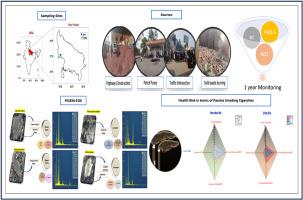Breathing like a smoker: Estimating relative risk of PM2.5, BC, and NO2 exposure in semi-urban India for better public perception
IF 3.7
2区 环境科学与生态学
Q2 ENVIRONMENTAL SCIENCES
引用次数: 0
Abstract
Despite being a leading cause of health issues, air pollution in smaller cities is often overlooked. To address this gap, annual monitoring of Fine Particulate Matter (PM2.5), Black Carbon (BC), and Nitrogen Dioxide (NO2) was conducted at a residential site in a semi-urban area and, for comparison, in an urban area. The sampling site was affected by multiple, co-located sources, including the National Highway (NH-19), traffic intersections, street vendor stalls, and other commercial areas, resulting in high exposure levels. The collected data were analyzed to understand the dynamics, variations, morphology, and chemical composition of particles; these levels were then assessed concerning passive cigarette smoke (PSC) exposure, evaluating potential health impacts. Four health outcomes—cardiovascular mortality (CM), lung cancer (LC), low birth weight (LBW), and decreased lung function (DLF) in school-aged children—were assessed to quantify the burden. The results indicate that even minimal concentrations can significantly affect human health, as a rise of 10 μg/m3 in PM2.5 and NO2, along with 1 μg/m3 in BC, is associated with mean increases and standard errors of 8.1 (3.98), 8.5 (4.48), and 3.03 (1.22) PSC per day across the four health outcomes, respectively. Seasonally, the post-monsoon period showed predominance due to extensive use of biomass and fossil fuels for heating and cooking in semi-urban regions, leading to an elevated prevalence of decreased lung function (DLF), with 18 passive cigarettes identified as the most significant risk factor among the various outcomes. This study emphasizes the need for population-based monitoring to issue public health advisories that protect vulnerable groups, especially in smaller cities such as Tundla, located in Northern India.

像吸烟者一样呼吸:估计印度半城市PM2.5、BC和NO2暴露的相对风险,以提高公众的认知
尽管空气污染是健康问题的主要原因,但小城市的空气污染往往被忽视。为了解决这一差距,在半城市地区的一个居民区进行了细颗粒物(PM2.5)、黑碳(BC)和二氧化氮(NO2)的年度监测,并在城市地区进行了比较。采样点受到多个共存源的影响,包括国家高速公路(NH-19)、交通十字路口、街头摊贩摊位和其他商业区,导致高暴露水平。对收集到的数据进行分析,以了解颗粒的动力学、变化、形态和化学成分;然后评估这些水平与被动香烟烟雾(PSC)暴露的关系,评估潜在的健康影响。评估了学龄儿童的四种健康结局——心血管死亡率(CM)、肺癌(LC)、低出生体重(LBW)和肺功能下降(DLF)——以量化负担。结果表明,即使是最小的浓度也会显著影响人类健康,因为PM2.5和NO2浓度每增加10 μg/m3, BC浓度每增加1 μg/m3,在四种健康结果中,每天的平均增加和标准误差分别为8.1(3.98)、8.5(4.48)和3.03 (1.22)PSC。季节性方面,由于在半城市地区广泛使用生物质和化石燃料进行供暖和烹饪,季风后时期表现出优势,导致肺功能下降(DLF)的患病率升高,18支被动香烟被确定为各种结果中最重要的风险因素。这项研究强调需要以人口为基础的监测,以发布保护弱势群体的公共卫生咨询,特别是在印度北部Tundla等较小城市。
本文章由计算机程序翻译,如有差异,请以英文原文为准。
求助全文
约1分钟内获得全文
求助全文
来源期刊

Atmospheric Environment
环境科学-环境科学
CiteScore
9.40
自引率
8.00%
发文量
458
审稿时长
53 days
期刊介绍:
Atmospheric Environment has an open access mirror journal Atmospheric Environment: X, sharing the same aims and scope, editorial team, submission system and rigorous peer review.
Atmospheric Environment is the international journal for scientists in different disciplines related to atmospheric composition and its impacts. The journal publishes scientific articles with atmospheric relevance of emissions and depositions of gaseous and particulate compounds, chemical processes and physical effects in the atmosphere, as well as impacts of the changing atmospheric composition on human health, air quality, climate change, and ecosystems.
 求助内容:
求助内容: 应助结果提醒方式:
应助结果提醒方式:


